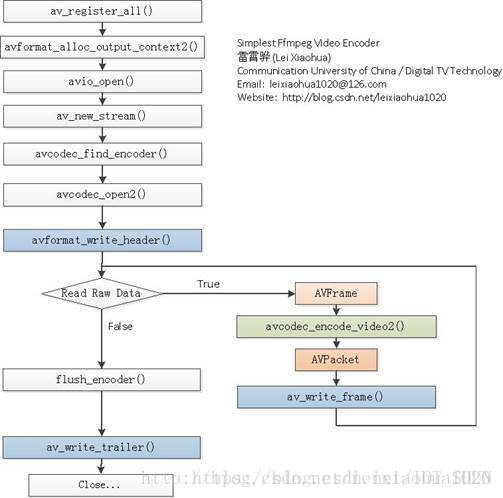下面附一张使用FFmpeg编码视频的流程图。使用该流程,不仅可以编码H.264的视频,而且可以编码MPEG4/MPEG2/VP8等等各种FFmpeg支持的视频。图中蓝色背景的函数是实际输出数据的函数。浅绿色的函数是视频编码的函数。

简单介绍一下流程中各个函数的意义:
av_register_all():注册FFmpeg所有编解码器。
avformat_alloc_output_context2():初始化输出码流的AVFormatContext。
avio_open():打开输出文件。
av_new_stream():创建输出码流的AVStream。
avcodec_find_encoder():查找编码器。
avcodec_open2():打开编码器。
avformat_write_header():写文件头(对于某些没有文件头的封装格式,不需要此函数。比如说MPEG2TS)。
avcodec_encode_video2():编码一帧视频。即将AVFrame(存储YUV像素数据)编码为AVPacket(存储H.264等格式的码流数据)。
av_write_frame():将编码后的视频码流写入文件。
flush_encoder():输入的像素数据读取完成后调用此函数。用于输出编码器中剩余的AVPacket。
av_write_trailer():写文件尾(对于某些没有文件头的封装格式,不需要此函数。比如说MPEG2TS)
#include <stdio.h>
#define __STDC_CONSTANT_MACROS
#ifdef _WIN32
//Windows
extern "C"
{
#include "libavutil/opt.h"
#include "libavcodec/avcodec.h"
#include "libavformat/avformat.h"
};
#else
//Linux...
#ifdef __cplusplus
extern "C"
{
#endif
#include <libavutil/opt.h>
#include <libavcodec/avcodec.h>
#include <libavformat/avformat.h>
#ifdef __cplusplus
};
#endif
#endif
int flush_encoder(AVFormatContext *fmt_ctx,unsigned int stream_index){
int ret;
int got_frame;
AVPacket enc_pkt;
if (!(fmt_ctx->streams[stream_index]->codec->codec->capabilities &
CODEC_CAP_DELAY))
return 0;
while (1) {
enc_pkt.data = NULL;
enc_pkt.size = 0;
av_init_packet(&enc_pkt);
ret = avcodec_encode_video2 (fmt_ctx->streams[stream_index]->codec, &enc_pkt,
NULL, &got_frame);
av_frame_free(NULL);
if (ret < 0)
break;
if (!got_frame){
ret=0;
break;
}
printf("Flush Encoder: Succeed to encode 1 frame!tsize:%5dn",enc_pkt.size);
/* mux encoded frame */
ret = av_write_frame(fmt_ctx, &enc_pkt);
if (ret < 0)
break;
}
return ret;
}
int main(int argc, char* argv[])
{
AVFormatContext* pFormatCtx;
AVOutputFormat* fmt;
AVStream* video_st;
AVCodecContext* pCodecCtx;
AVCodec* pCodec;
AVPacket pkt;
uint8_t* picture_buf;
AVFrame* pFrame;
int picture_size;
int y_size;
int framecnt=0;
//FILE *in_file = fopen("src01_480x272.yuv", "rb"); //Input raw YUV data
FILE *in_file = fopen("output.yuv", "rb"); //Input raw YUV data
int in_w=480,in_h=272; //Input data's width and height
int framenum=100; //Frames to encode
//const char* out_file = "src01.h264"; //Output Filepath
//const char* out_file = "src01.ts";
//const char* out_file = "src01.hevc";
const char* out_file = "ds.h264";
av_register_all();
//Method1.
pFormatCtx = avformat_alloc_context();
//Guess Format
fmt = av_guess_format(NULL, out_file, NULL);
pFormatCtx->oformat = fmt;
//Method 2.
//avformat_alloc_output_context2(&pFormatCtx, NULL, NULL, out_file);
//fmt = pFormatCtx->oformat;
//Open output URL
if (avio_open(&pFormatCtx->pb,out_file, AVIO_FLAG_READ_WRITE) < 0){
printf("Failed to open output file! n");
return -1;
}
video_st = avformat_new_stream(pFormatCtx, 0);
//video_st->time_base.num = 1;
//video_st->time_base.den = 25;
if (video_st==NULL){
return -1;
}
//Param that must set
pCodecCtx = video_st->codec;
//pCodecCtx->codec_id =AV_CODEC_ID_HEVC;
pCodecCtx->codec_id = fmt->video_codec;
pCodecCtx->codec_type = AVMEDIA_TYPE_VIDEO;
pCodecCtx->pix_fmt = AV_PIX_FMT_YUV420P;
pCodecCtx->width = in_w;
pCodecCtx->height = in_h;
pCodecCtx->bit_rate = 400000;
pCodecCtx->gop_size=250;
pCodecCtx->time_base.num = 1;
pCodecCtx->time_base.den = 25;
//H264
//pCodecCtx->me_range = 16;
//pCodecCtx->max_qdiff = 4;
//pCodecCtx->qcompress = 0.6;
pCodecCtx->qmin = 10;
pCodecCtx->qmax = 51;
//Optional Param
pCodecCtx->max_b_frames=3;
// Set Option
AVDictionary *param = 0;
//H.264
if(pCodecCtx->codec_id == AV_CODEC_ID_H264) {
av_dict_set(¶m, "preset", "slow", 0);
av_dict_set(¶m, "tune", "zerolatency", 0);
//av_dict_set(¶m, "profile", "main", 0);
}
//H.265
if(pCodecCtx->codec_id == AV_CODEC_ID_H265){
av_dict_set(¶m, "preset", "ultrafast", 0);
av_dict_set(¶m, "tune", "zero-latency", 0);
}
//Show some Information
av_dump_format(pFormatCtx, 0, out_file, 1);
pCodec = avcodec_find_encoder(pCodecCtx->codec_id);
if (!pCodec){
printf("Can not find encoder! n");
return -1;
}
if (avcodec_open2(pCodecCtx, pCodec,¶m) < 0){
printf("Failed to open encoder! n");
return -1;
}
pFrame = av_frame_alloc();
picture_size = avpicture_get_size(pCodecCtx->pix_fmt, pCodecCtx->width, pCodecCtx->height);
picture_buf = (uint8_t *)av_malloc(picture_size);
avpicture_fill((AVPicture *)pFrame, picture_buf, pCodecCtx->pix_fmt, pCodecCtx->width, pCodecCtx->height);
//Write File Header
avformat_write_header(pFormatCtx,NULL);
av_new_packet(&pkt,picture_size);
y_size = pCodecCtx->width * pCodecCtx->height;
for (int i=0; i<framenum; i++){
//Read raw YUV data
if (fread(picture_buf, 1, y_size*3/2, in_file) <= 0){
printf("Failed to read raw data! n");
return -1;
}else if(feof(in_file)){
break;
}
pFrame->data[0] = picture_buf; // Y
pFrame->data[1] = picture_buf+ y_size; // U
pFrame->data[2] = picture_buf+ y_size*5/4; // V
//PTS
//pFrame->pts=i;
pFrame->pts=i*(video_st->time_base.den)/((video_st->time_base.num)*25);
int got_picture=0;
//Encode
int ret = avcodec_encode_video2(pCodecCtx, &pkt,pFrame, &got_picture);
if(ret < 0){
printf("Failed to encode! n");
return -1;
}
if (got_picture==1){
printf("Succeed to encode frame: %5dtsize:%5dn",framecnt,pkt.size);
framecnt++;
pkt.stream_index = video_st->index;
ret = av_write_frame(pFormatCtx, &pkt);
av_free_packet(&pkt);
}
}
//Flush Encoder
int ret = flush_encoder(pFormatCtx,0);
if (ret < 0) {
printf("Flushing encoder failedn");
return -1;
}
//Write file trailer
av_write_trailer(pFormatCtx);
//Clean
if (video_st){
avcodec_close(video_st->codec);
av_free(pFrame);
av_free(picture_buf);
}
avio_close(pFormatCtx->pb);
avformat_free_context(pFormatCtx);
fclose(in_file);
return 0;
}
最后
以上就是愉快诺言最近收集整理的关于FFMPEG(YUV编码为H.264)的全部内容,更多相关FFMPEG(YUV编码为H内容请搜索靠谱客的其他文章。
本图文内容来源于网友提供,作为学习参考使用,或来自网络收集整理,版权属于原作者所有。








发表评论 取消回复